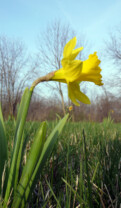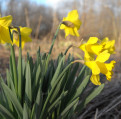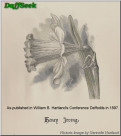

Unknown
UnknownFl. yellow; perianth segments broadly ovate, blunt, spreading, ribbed, with margins wavy or recurved, overlapping one-third; corona funnel-shaped, mouth widely flanged, rim deeply and irregularly notched and crenate. According to a reputable bulb source for historics, at least two clones seem to exist.
Published in the 1953 RHS Yearbook – “Early Daffodils” by H.W. Abbis: “This variety abounded in the granite grits and coastal pockets of West Cornwall and the fortunes of many have been made from this old friend. When, however, we put up our public sterilizing plant to clean up an eel worm-riddled industry in 1926, followed by many privately owned plants, it sounded the death knell for ‘Irving’. It could not stand the hot-water treatment, and basal rot, in spite of the use of Uspulun in the baths, invaded the stocks and now this Daffodil has practically disappeared. Many early (season) new varieties have the same failing.”
Is this daffodil’s origin actually Ireland?
Named in honor of the British actor Sir Henry Irving for his cultural and artistic contribution to the Victorian Era.
'Irving', 'Sir Henry Irving', 'Spurius Henry Irving'
 Henry Irving, 1 Y-Y, Unknown Hybridizer, the Netherlands, 1885
Henry Irving, 1 Y-Y, Unknown Hybridizer, the Netherlands, 1885
Photo #42294 Drew Mc Farland, USA Henry Irving, 1 Y-Y, Unknown Hybridizer, the Netherlands, 1885
Henry Irving, 1 Y-Y, Unknown Hybridizer, the Netherlands, 1885
Photo #41123 Kirby Fong, USA Henry Irving, 1 Y-Y, Unknown Hybridizer, the Netherlands, 1885
Henry Irving, 1 Y-Y, Unknown Hybridizer, the Netherlands, 1885
Photo #31789 Drew Mc Farland, USA Henry Irving, 1 Y-Y, Unknown Hybridizer, the Netherlands, 1885
Henry Irving, 1 Y-Y, Unknown Hybridizer, the Netherlands, 1885
Photo #16720 Gertrude Hartland, Ireland Henry Irving, 1 Y-Y, Unknown Hybridizer, the Netherlands, 1885
Henry Irving, 1 Y-Y, Unknown Hybridizer, the Netherlands, 1885
Photo #10078 Carlos van der Veek, the Netherlands Henry Irving, 1 Y-Y, Unknown Hybridizer, the Netherlands, 1885
Henry Irving, 1 Y-Y, Unknown Hybridizer, the Netherlands, 1885
Photo #9135 Kirby Fong, USA
![]()